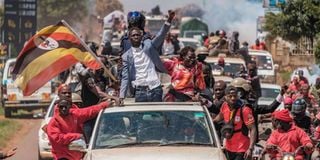Why Uganda election is so brutal

Bobi Wine, Uganda's opposition presidential candidate in the January 14, 2021 elections, during one of his recent campaigns..
What you need to know:
- Since independence in 1962, Uganda has had neither a free and fair election nor a democratic transition to a leader either in the ruling party or opposition through popular vote.
- The military and militarisation have been at the core of the Ugandan state since colonial days.
Today, Uganda votes in an election that is all but set to return President Yoweri Kaguta Museveni, who has been running things there for all of 34 years, to power.
The run-up to the elections have been marked by shocking levels of violence with over five dozen people killed. Even more striking, in an already highly militarised state, the militarisation has been amped up.
This week, social media was swamped with videos and photos of large armoured vehicle convoys putting on a show of force in perceived opposition strongholds in the capital Kampala and long columns of troops in menacing battle dress prowling various parts of the city.
The physical abuses of the unyielding youthful musician-turned-politician Robert Kyagulanyi aka Bobi Wine and the Forum for Democracy’s Patrick Amuriat are the kind that would usually be reserved for a really threatening foreign enemy.
Since independence in 1962, Uganda has had neither a free and fair election nor a democratic transition to a leader either in the ruling party or opposition through popular vote. All its elections were marked by violence and brazen vote rigging.
There are many reasons for this. But a constant one has been the role of the military in influencing the dynamics of election politics, or its direct control of power. Most outsiders, and indeed Ugandans, see this as a peculiarity of President Museveni’s rule, following his ascendance to power in 1986 after a five-year guerrilla war.
But that is a limited reading. The military and militarisation have been at the core of the Ugandan state since colonial days. And it differentiates itself from the other countries in the region in that it comes with a strong foreign interventionist streak.
The military dictator Idi Amin, who would seize power for himself in 1971, together with a few other Ugandans had a fabled career in the colonial King’s African Rifles (KAR). Horrid stories are told of Amin’s role in the British campaign against the Somali Shifta rebels in 1949 and Kenya’s Mau Mau freedom fighters.
In 1964, Kampala got embroiled in the Democratic Republic of Congo aiding Christophe Gbenye, who was leading a rebellion in the eastern part of the country that shares a border with Uganda.
Uganda also historically supported the rebellions in southern Sudan, from the immediate post-independence government of Dr Milton Obote to Amin’s, and in a big way during the Museveni presidency. Uganda People’s Defence Forces (UPDF) is, really, what is keeping President Salva Kiir in power in Juba. In that sense, Uganda has been in South Sudan for over 50 years.
Foiled coup
Of course, Uganda was the platform from which the Rwanda Patriotic Front/Army launched its war to regain statehood in October 1990. With Rwanda, it was a key player in the ouster of the thieving autocrat Mobutu Sese Seko in then-Zaire (now DRC) in 1997. And it has never really left DRC, continuing to station there and into the Central African Republic against the Uganda Islamist rebels Allied Democratic Forces (ADF) and Joseph Kony’s Lord’s Resistance Army (LRA).
After the foiled coup of late December 2017 against Equatorial Guinea’s Teodoro Obiang Nguema, one of two men, the other being Cameroon’s Paul Biya, who have been in power longer than Museveni in Africa, he reached out to Kampala. Today, UPDF is Nguema’s key keeper in Malabo.
There are many reasons why Uganda is so restless but the same history also informs some of its brutal electoral politics. The area that is Uganda today had an array of some of the most developed states (kingdoms) in East Africa with Buganda years ahead of anything one could find in the region.
The map of lagoons and drainage systems of the Buganda kingdom of the 1880s shows they were probably more advanced than those of many towns in East Africa today.
Additionally, Christianity was organised in Uganda, partly as a bridgehead into central Africa. Until the early 1960s, the Anglican church territory was one big thing from Uganda, Congo, Rwanda and Burundi and its chief sat in Kampala.
All this meant the post-independence state had few ‘free’ subjects who were not under the authority of, or didn’t owe their loyalty to, a kingdom, chieftainship or entrenched church. To bring these under them, governments have chosen to use force, as if they were capturing them from a foreign country like in the 18th century.
In reality, none of these historical state structures are visible but the DNA of the State in handling them violently hasn’t changed.
Moreover, even when governments have changed through war, there has always been continuity in the military and its traditions. Every military or liberation movement has had in its ranks leading soldiers from the order it was fighting.
A more fluid Kenyan-style election is creeping up in Uganda, for sure. But it will likely be another 20 years before it settles in.
Mr Onyango-Obbo is a journalist, writer and curator of the Wall of Great Africans. @cobbo3





